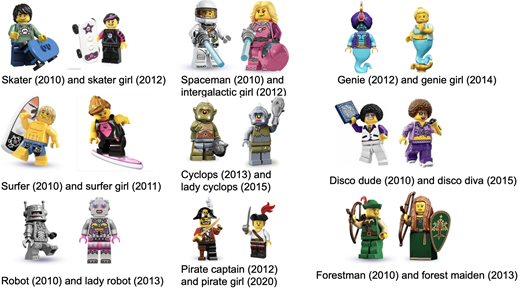
Gender bias and discrimination could not be clearer when looking at the LEGO CMFs. Looking at and analyzing CMFs from series 1 through series 20, the representation of girls and women can be seen throughout time. In this article, we will compare and contrast the difference in names of female and male CMFs, the disparity between female and male CMF pairs’ release dates, the difference in numbers of female and male CMFs without a male or female pair, as well as the difference in appearance of female CMFs and their male match.
First, we compared female and male CMF names. Words have power and so much can be said, and implied, through language. There are many differences and disparities between male and female CMF names. The most noticeable one is the addition of “girl,” “woman,” or other female descriptors to female CMFs. Below are examples of this:
Male: Tribal Chief (2011) Female: Tribal Woman (2016)
Male: Surfer (2010), Pro Surfer (2017) Female: Surfer Girl (2011)
Male: Skater (2010) Female: Skater Girl (2012)
Male: Spaceman (2010) Female: Intergalactic Girl (2012)
Male: Viking (2011) Female: Viking Woman (2012)
Male: Punk Rocker (2011) Female: Rocker Girl (2012)
Male: Thespian (2012) Female: Hollywood Starlet (2013)
Male: Robot (2010) Female: Lady Robot (2013)
Male: Waiter (2013) Female: Diner Waitress (2013)
Male: Highland Battler (2012) Female: Battle Goddess (2014)
Male: Genie (2012) Female: Genie Girl (2014)
Male: Cyclops (2013) Female: Lady Cyclops (2015)
Male: Disco Dude (2010) Female: Disco Diva (2015)
Male: Zombie (2010) Female: Zombie Cheerleader (2015)
Male: Pirate Captain (2012) Female: Pirate Girl (2020)
LEGO implies through the names of the CMFs that male is the norm and female is an inferior addition that requires more clarification. The use of “girl” in many cases is demeaning and infantilizing, suggesting that the female CMF is less significant and worthy of the standard name. Not only this, but the majority of the “girl” CMFs are in fact not girls; rather, they are women with a name that diminishes their presence. Below are all of the female CMFs throughout time that have “girl” in their name.
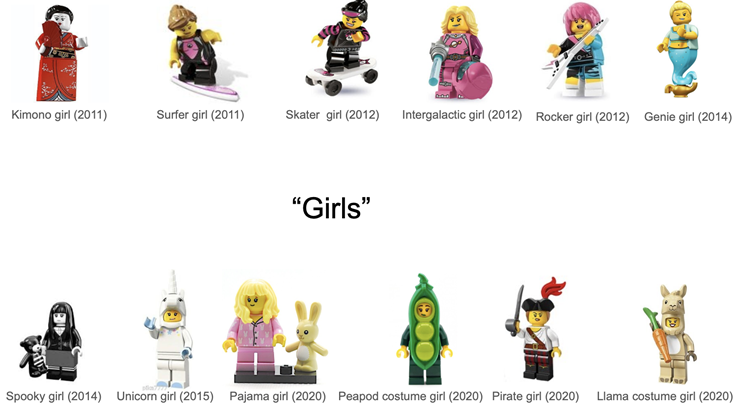
The twelve “girl” CMFs could not look more different in appearance and age range. The term, “girl,” unless used to describe a female child (like Pajama Girl in 2020), takes away from who each of the female CMFs really are and from the activities they do. For example, the male “Surfer” in 2010 and “Pro Surfer” in 2017 have very different implications from “Skater Girl” in 2011. We can compare these “girls” to all of the “boys” in the CMF series.

4 out of 6 “boys” are in fact male children, which can be seen by the shorter legs. This contrasts the 1 out of 12 “girls” who have short legs, meaning that the “boys” are boys and the “girls” are women who are not respected and recognized as women.
Added terms such as “girl” and “boy” make up many of the CMFs; however, when comparing terms used for female and male CMFs, there is an unsettling difference.
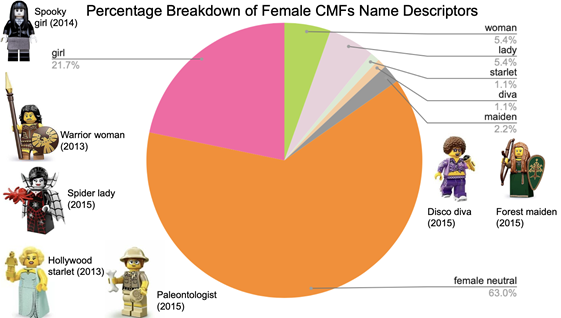
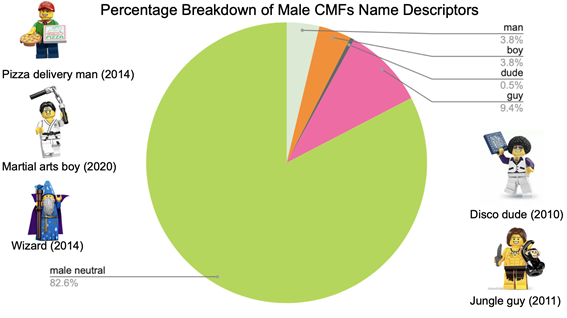
LEGO uses 6 female descriptors in comparison to 4 male descriptors (this discounts “female neutral” and “male neutral” names such as Paleontologist (2015) and Wizard (2014) that do not explicitly define the gender of the CMF). Other than neutral names, “girl” is used most often for female CMFs and “guy” is used the most for male CMFs (while “boy” is tied with “man”). The terms “girl” and “guy” are not equivalent. “Girl” implies innocence and immaturity while “guy” suggests someone older. SOMETHING.
The most striking difference, however, are the descriptors themselves. While male CMFs have “guy,” “man,” “boy,” and “dude,” female CMFs have “girl,” “woman,” “lady,” “maiden,” “starlet,” and “diva.” None of the male descriptors imply any sort of characteristic or personality trait (other than age); however, the female descriptors do. Below are definitions of some of these descriptors from Merriam-Webster:
Lady: a woman having proprietary rights or authority especially as a feudal superior
Maiden: an unmarried girl or woman
Starlet: a young movie actress being coached and publicized for starring roles.
Diva:
- A principal female singer in an opera or concert organization
- A vain or undisciplined person who finds it difficult to work under direction or as part of a team
Each of these descriptors imply a social status, marital status, or a negative personality trait, defining and categorizing the female CMFs and their characters far more than those of the male CMFs. Not only do these additional, female descriptors affect the way the minifigs are perceived, they also push them away from spotlight, making them a side character to their male match.
The difference in appearance between the male and female CMFs is equally striking. Below are a few examples of pairs with very different names and appearances.

These side-by-side comparisons speak for themselves; however, notice the addition of pink, the more skin that is revealed, and the makeup. The female CMF names already suggest that they are more like side characters than an equal match to their male counterparts and the appearance of the female CMFs reinforces this, taking the blueprint of the male CMF and adding a crop top, some pink, and long hair. Because of this, it feels that the male CMFs have thought out characters and personalities, while the female CMFs appear to be an afterthought.
Next, we examined when each CMF was released and the disparity of time in between when the male and female CMFs in pairs were released. Below is a chart that displays the CMF pairs throughout time based on when the first CMF (whether that was female or male) was released, tracking the pairs from 2010 to 2020.
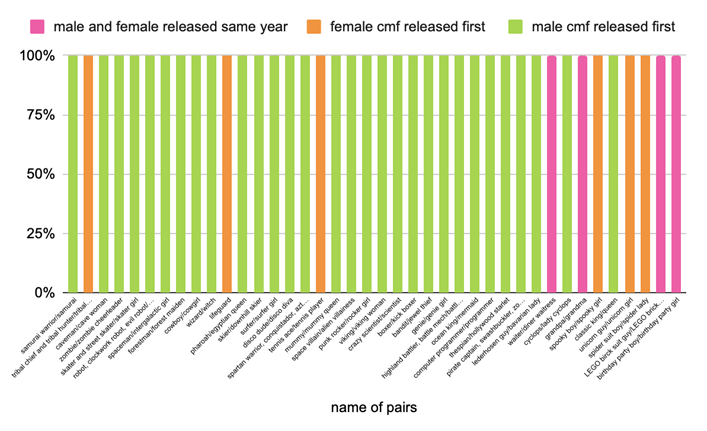
It was, and still is a rarity if a female CMF is released before the male CMF in its pair. Approaching 2020, this has gotten better with more female CMFs being released first and more male and female CMFs being released in the same year. Below is a chart that displays the disparity between male CMFs released first and female CMFs released first.
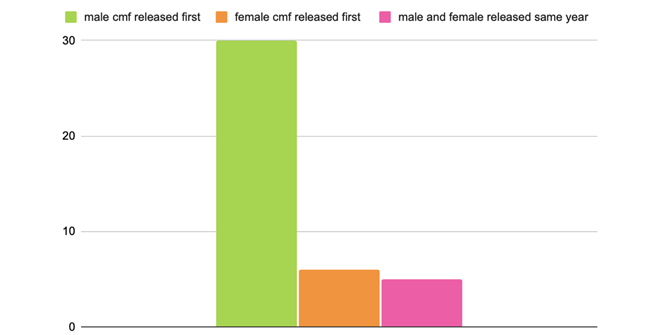
The male CMFs were released first in 30 of the 40 CMF pairs. The female CMFs were released first in only 6 out of 40 of the pairs. 4 out of 40 of the pairs were released in the same year. Once again, the female CMFs are afterthoughts, added to their male pair years later once the male CMF had its time to shine.
The disparities only grow as we examine the male and female CMFs released still without a pair. Below is a chart that illustrates this difference.
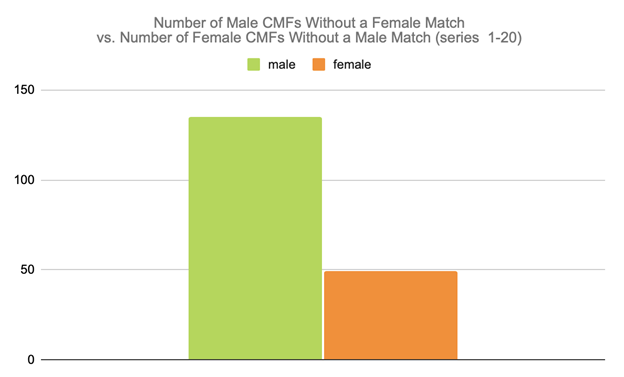
Being largely thought of and released first, male CMFs have far more individual minifigures without a female match. On the flip side, female CMFs are generally released after their male match and are not thought of first, leaving them with far fewer minifigures without a male match. Again and again we see this pattern repeated in every aspect of the female CMFs: they are created and released as afterthoughts.


1 comment
Lara Granger
I would disagree with the usage of a few minifigures:
1. Typically, a waiter mostly has exclusive connotations to a man, while waitress is an exclusively female term. You may want to google the definition of ‘waiter’.
2. Thespian and Hollywood Starlet are not counter-parts. Although they are both actors, it’s obvious to see that both of them are from different acting disciplines: theatre and film. Therefore, the ‘Starlet’ doesn’t have a counterpart.
3. The Highland Battler and Warrior Goddess couldn’t be more unique. They seem to be based on different cultures: the Battler as a Celtic warrior and the Goddess has similarities to Athena, the Greek Goddess of battle. Not to mention that she is a GODDESS, not a mortal warrior.
4. Why include Disco ‘Dude’ when you’re basing your research on how male minifigures have neutral terms? It does nothing to support your argument. Dude is usually a male term.
5. What’s wrong with Zombie Cheerleader? That’s exactly what she is. Don’t forget in the very same series she came in (Series 14), there was also a Zombie Pirate and Zombie Businessman. The zombie you refer to from series one was more or less a generic variant. ‘Cheerleader’ works more as a job description than a gender defining trait, in regards to the context.
Also, most of the minifigures you list as counterparts are from at least seven or eight years ago. I think we can let it slide, albeit whilst acknowledging a troubled past.